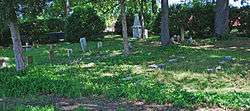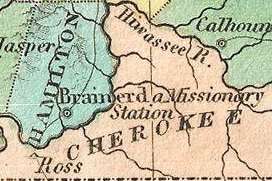Brainerd Mission
The Brainerd Mission was a Christian mission to the Cherokee in present-day Chattanooga, Tennessee. The associated Brainerd Mission Cemetery is the only part that still remains, and is listed on the National Register of Historic Places.
Brainerd Mission Cemetery | |
 Brainerd Mission Cemetery | |
  | |
| Location | 5700 Eastgate Loop, Chattanooga, Tennessee |
|---|---|
| Area | 1 acre (0.40 ha) |
| Built | 1817 |
| Architect | William Crutchfield |
| NRHP reference No. | 79002435[1] |
| Added to NRHP | December 6, 1979 |

History
Brainerd Mission was established in 1817 by Cyrus Kingsbury, working on behalf of the American Board of Commissioners for Foreign Missions (ABCFM). The site was a tract on South South Chickamauga Creek, near present-day Chattanooga, previously owned by John McDonald, a former Scots trader and grandfather of John Ross, the future principal chief of the Cherokee Nation.[2][lower-alpha 1] Originally named Chickamauga Mission, it was renamed Brainerd Mission several months later, in honor of David Brainerd, an early New England Indian missionary.[3]
When the site was acquired, it contained only a dilapidated gristmill and a few other buildings. Within a short time, the missionaries, assisted by Cherokees living in the neighborhood, had added separate schoolhouses and dwellings for boys and girls, a cemetery, sawmill, blacksmith shop, wash house, meat house (smokehouse), corn house and stables. They also built a missionary residence. By the end of the year, they had also cleared and fenced about 40 acres (160,000 m2) to create a farm.[2]
The aims of the mission were to provide a basic education to Cherokee children, while also instilling Christian religious values.[4] Specifically, this included learning to read and write the English language, and to read the English bible. The missionaries also taught the girls spinning, knitting, and sewing. The boys were taught animal husbandry, farming and mechanical skills.[2]
Before the end of 1818, the ABCFM withdrew Cyrus Kingsbury and sent him to Mississippi as a missionary to the Choctaw Nation. Kingsbury continued serving the Choctaws for the rest of his active career.
Notable missionaries
Several prominent missionaries served at Brainerd Mission at various times; people such as Samuel Worcester,[3] Ainsworth Blunt[5] and Cephas Washburn. On May 27, and 28th, 1819, President James Monroe visited Brainerd Mission with General Edmund Pendleton Gaines. This was the first presidential visit to the Hamilton County area.[3] He donated $1,000 to the work of the Mission. The mission officially closed on October 2, 1838. because of the Cherokee removal to Indian Territory.[2] In total, the Brainerd Mission served over 300 male and female Cherokee over its 21 years of operation.[4] It was modestly successful in reaching its stated goals, providing many of its students with a basic level of English proficiency. It was less successful in its goal of religious conversion, with only a few Cherokee joining the church.[4]
All that remains of the mission is the cemetery which is cared for by the Daughters and Sons of the American Revolution.[2] The site of the mission itself now occupied by the Eastgate Shopping Center. The cemetery is one of the oldest in Hamilton County and consists of 60 graves, most of which are of missionary workers. The Daughters of the American Revolution were integral to the preservation of the site, and continue to own and maintain the cemetery.
Notable students
A relatively small number of students who had graduated from Brainerd Mission became notable figures later in life. The number includes:[2]
- Elias Boudinot, who became founder and editor of the Cherokee Phoenix, the first Cherokee newspaper; Boudinot was also a signer of the 1835 New Echota treaty.
- John Ridge, son of Major Ridge and cousin of Elias Boudinot. Both Ridges were major supporters of the 1835 New Echota treaty.
- David Brown (1806-1829), Cherokee clergyman who translated the New Testament into Cherokee from English, using the Sequoyah syllabary.
- Catharine Brown (ca.1800-1823), sister of Cherokee clergyman David Brown, first Cherokee convert to Christianity, and who became an instructor at Creek Path school in Alabama.
See also
| Wikimedia Commons has media related to Brainerd Mission. |
- Daniel Sabin Butrick (Buttrick)
- Cherokee Nation (19th century)
- Mission (Christianity)
- Samuel Worcester
Notes
- The location is now Brainerd Village, Osborne Office Park and the Brainerd Walmart in Chattanooga.[2]
References
- "National Register Information System". National Register of Historic Places. National Park Service. July 9, 2010.
- Rozema, Vicki. "Rozema: The Brainerd Mission and Chattanooga history." Times Free Press. March 9, 2014. Accessed April 10, 2018.
- Weston., Livingood, James (1981). A history of Hamilton County, Tennessee. [Memphis, Tenn.]: Memphis State University Press. ISBN 0-87870-204-0. OCLC 8218042.
- "Brainerd Mission | Entries | Tennessee Encyclopedia". tennesseeencyclopedia.net. Retrieved 2017-09-14.
- Phillips, Paul Gary (1998). The Brainerd Journal. ISBN 0803237189. Retrieved 2009-07-13.
Further reading
- Bass, Althea. “Cherokee Messenger.” University of Oklahoma Press, 1936
- Rozema, Vicki. "Rozema: The Brainerd Mission and Chattanooga history." Times Free Press. March 9, 2014.
- Walker, Robert Sparks. Torchlights to the Cherokees; The Brainerd Mission. New York: The Macmillan Company, 1931.
External links
- Brainerd Mission Cemetery
- History of Brainerd Mission Cemetery, text compiled from 2003 National Park Service Update of National Register of Historic Places by Bettie H. Purcell.
- An Archaeological Survey of the Brainerd Mission Cemetery